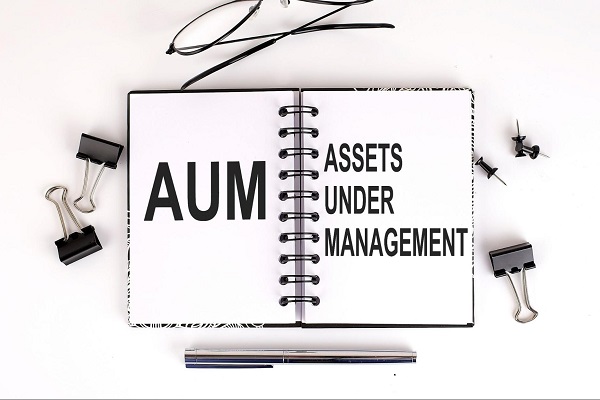Understanding Assets Under Management (AUM) in Mutual Fund

A mutual fund scheme comprises investments of several investors. The combined value of all the investments in a mutual fund scheme is known as Assets Under Management or AUM. The AUM keeps on changing from time to time based on investments made or pulled out of the scheme.
Let’s understand how AUM works in mutual funds and what its impact is.
What is AUM?
The total market value of the capital and assets held (and managed) by a mutual fund scheme is known as AUM. The full form of AUM is Assets Under Management.
The fund manager administers these assets and makes all investment-related decisions on behalf of the investors. AUM is a measure of a given fund house’s size and performance. The assets under management of a fund can be easily compared with other similar funds’ performance over time.
The return a mutual fund receives is also factored into the AUM value. Now, this return can be held, invested into securities, or paid out as dividends to investors (as directed by the investment mandate).
AUM is one of the many factors considered when assessing a business or an investment and is frequently taken into account together with management experience and performance. Higher AUM and investment inflows are often viewed as positive signs by investors.
How Does AUM Work?
AUM generally refers to funds that the manager can employ for transactions based on their discretion. For example, if an individual invests Rs.1 lakh in a mutual fund scheme, that sum would be pooled with other investors’ investments into the AUM.
So, without requesting special approval, the fund manager can use the invested funds to acquire and manage the AUM.
It’s also important to keep in mind that the manager (of the assets in your mutual funds) will charge a management fee to cover their compensation and fixed administrative expenses.
The payment will typically be a set rate charged to the entire fund and is allocated proportionately to each investor. When more investors invest in a fund, the AUM will rise, and the opposite will happen when fewer individuals invest in the fund.
Importance of Assets Under Management
AUM aids in increasing the firm’s market value. It could also be used as a marketing strategy to attract new clients.
The investment firm, brokerage house, or portfolio manager can earn more credibility, eventually leading to additional clients and funding for the business.
It is essential to analyse the returns of every asset under management since it shows which investment choices performed as anticipated, which ones outperformed, and which ones underperformed. Higher returns typically indicate that assets are being managed effectively.
A mutual fund with a sizable AUM could have a strong trust factor. Additionally, AUM can also be used as a liquidity indicator in the event of a big redemption. This is especially true for liquid and overnight funds, which are vulnerable to large redemptions by institutional investors.
Higher AUM for these funds indicates a better ability for shock offloading absorption.
Also Read
Impacts of AUM on Mutual Funds
A sizable asset fund can enable an asset manager to respond to shifting market opportunities by exiting or entering a specific investment when one presents itself. AUM is frequently used by investors to also calculate performance and returns. Following are the importance of AUM with respect to various investment options:
a. Equity funds
In an ideal scenario, equity funds have the potential to provide a positive return and outperform the benchmark index during market highs and lows. Equity funds rely more on the asset manager’s ability to increase returns than they do on AUM.
b. Debt funds
Total assets are one of the most important components of debt funds. Debt funds with more capital can distribute their expenses among more investors, lowering fixed fund expenses for each investor and raising returns.
c. Small-cap funds
These are typically not highly dependent on Asset Under Management and are only affected when the assets exceed a certain threshold, specifically when fund houses become the major shareholders in a particular company.
d. Large-cap funds
The yields offered by the market are the main factor influencing the returns generated by large-cap funds. Generally speaking, it is independent of the asset under management. When compared to companies with more assets, there are several instances where companies with smaller asset classes have generated significantly more revenues despite their shareholders purchasing significantly fewer shares of those institutions.
AUM growth can occasionally have a negative impact on an equity fund’s performance too. However, there is hardly any evidence to suggest that a higher AUM directly impacts the fund performance.
The fund manager is ultimately responsible for the fund’s performance. Larger assets under management have frequently made it more difficult for the manager to make quick investment decisions.
Before investing, one needs to evaluate the fund’s performance in relation to the benchmark and its competitors.
Before we move on, did you know that Navi Nifty 50 has crossed 500 crore in AUM? Now is the time to start investing with Navi Mutual Fund. We are home to a host of low-cost index funds catering to various investment goals and objectives. Download the Navi app and start investing today!
Disclaimer: Mutual fund investments are subject to market risks, read all scheme related documents carefully.
How to Calculate Assets Under Management?
Asset Under Management (AUM) is the total value of assets managed by the fund. It is the sum of all the money invested in the fund by its investors, plus any assets earned from investments held in the fund that have not been distributed to investors.
AUM is commonly expressed as a percentage of total fund capital. For example, if a mutual fund has $100 million in assets under management [AUM], then AUM = 100/1,000,000 = 10%.
Now, Asset Under Management can be calculated using several different methods. The most common method is calculating AUM by dividing total assets by total capital. In this case, it makes sense to use a long-term growth rate, such as the annualised return on investment (ROI), which considers both positive and negative returns.
Another method is to look at AUM relative to net assets, which can be done by calculating AUM relative to total net assets or gross assets.
Another calculation is net asset value per share x number of shares held. This can give an accurate picture of each individual investor’s contribution to the overall fund.
Remember, Asset Under Management fluctuates daily, reflecting the varying returns from stocks and mutual funds as well as fluctuations in fixed investment prices.
How Important is AUM for Investing?
The level of AUM is a gauge of a company’s success, whether dealing with banks, asset managers, insurance firms, or other financial organisations. This is generally because it is correlated with other key performance indicators.
The size of Asset Under Management is also an insight into the institution and its management’s prestige. Additionally, the AUM size often influences the compensation and bonus packages of the management.
Difference Between AUA and AUM?
AUA (Assets under Administration) assists with tax reporting, funds accounting and several other administrative services related to the fund, whereas an AUM refers to the total market value of the capital and assets held and managed by a mutual fund
Also Read
Final Word
Asset Under Management( AUM) is the total capital and asset value managed and held by asset management companies /mutual funds. It is used to calculate management fees and rank portfolio managers and funds based on it.
Remember, a larger AUM is not a guarantee of better performance, and it is important to not base all your investment choices on a fund’s AUM. It should be taken into account alongside other metrics, such as a fund’s historical performance, expense ratio, risk ratio, fund house history, fund manager reputation, risk-management tactics, compliance, and more.
FAQs on Assets Under Management
Ans. Mutual funds are an investment instrument where investors pool money for a common investing goal. AUM in finance is the total value of financial assets held by a mutual fund or asset management company.
Ans. There is hardly any evidence to suggest that a higher AUM directly impacts the fund performance. The fund manager is the one who should seize market opportunities and buy or sell a stock at the appropriate moment.
Ans. AUA is the total amount of assets that an institution provides administrative services for and is often charged as a percentage of the assets.
Want to put your savings into action and kick-start your investment journey 💸 But don’t have time to do research? Invest now with Navi Nifty 50 Index Fund, sit back, and earn from the top 50 companies.
Disclaimer: Mutual Fund investments are subject to market risks, read all scheme-related documents carefully.
This article has been prepared on the basis of internal data, publicly available information and other sources believed to be reliable. The information contained in this article is for general purposes only and not a complete disclosure of every material fact. It should not be construed as investment advice to any party. The article does not warrant the completeness or accuracy of the information and disclaims all liabilities, losses and damages arising out of the use of this information. Readers shall be fully liable/responsible for any decision taken on the basis of this article.

Customer’s Feedback
No comments found.10 Best Demat Accounts in India for Beginners in 2023
Creation of Demat accounts revolutionised the way trades were conducted at the stock exchanges. It... Read More »10 Best SIP Plans for 1000 Per Month in India 2023
Systematic Investment Plan (SIP) is an investment style or route with which you can invest a fixed ... Read More »How to Invest in Mutual Funds in India – Easy Steps
Mutual funds can be an excellent way to diversify your portfolio and gain exposure to a wide range ... Read More »20 Best Nifty 50 Index Funds in India to Invest in April 2023
What is the Nifty 50 Index Fund? Nifty 50 index funds are a type of passively-managed equi... Read More »Asset Management Company (AMC) – Types and Benefits
What is an Asset Management Company (AMC)? Asset Management Company or AMC is a financial ... Read More »10 Best Gold Mutual Funds to Invest in India (April 2023)
Gold Mutual Funds are funds that invest in gold and gold-related assets such as bullion, coin... Read More »20 Best Flexi Cap Mutual Funds to Invest in India 2023
Flexi-cap funds are mutual fund schemes that aim to invest in stocks of companies across market cap... Read More »Best SIP Plans for 15 years – Top 10 SIP Plans to Invest in India 2023
A systematic investment plan (SIP) could be a convenient mode or style of investing in mutual funds... Read More »10 Best SIP Plans for 1 year Investment in India 2023
There has been a massive surge in SIP or Systematic Investment Plan investors in recent years. As p... Read More »10 Best SIP Plan for 3 Years in India to Invest in 2023
SIP or Systematic Investment Plan helps bring investment discipline in an investor’s life. It’s... Read More »10 Best SIP Plan for 10 years India in 2023 – Returns and Performance
Ask any beginner mutual fund investor and most of them would tell you that their preferred mode of ... Read More »10 Best SIP Plans for 5 years in India to Invest in 2023
Systematic Investment Plan (SIP) could be an effective investment mode if you want to invest a fixe... Read More »Top 10 Chit Fund Schemes in India in 2023
Chit funds are one of the most popular return-generating saving schemes in India. It is a financial... Read More »10 Best Gold ETFs in India to Invest in April 2023
Gold ETFs or Gold Exchange Traded Funds are passively managed funds that track the price of physica... Read More »10 Best Demat Accounts in India for Beginners in 2023
Creation of Demat accounts revolutionised the way trades were conducted at the stock exchanges. It... Read More »20 Best Index Funds to Invest in India in April 2023
What is an Index Fund? An index fund is a type of mutual fund or exchange-traded fund (ETF) that... Read More »Best Arbitrage Mutual Funds to Invest in India in April 2023
Arbitrage funds are hybrid mutual fund schemes that aim to make low-risk profits by buying and sell... Read More »10 Best SIP Plans in India to Invest in April 2023
What is SIP? SIP or Systematic Investment Plan is a method of investing a fixed amount in ... Read More »10 Best Corporate Bond Funds in India to Invest in April 2023
Corporate bond funds are debt funds that invest at least 80% of the investment corpus in companies ... Read More »10 Best Bank for Savings Account in India [Highest Interest Rate 2023]
Savings account is a type of financial instrument offered by several banks. It lets you safely depo... Read More »

































